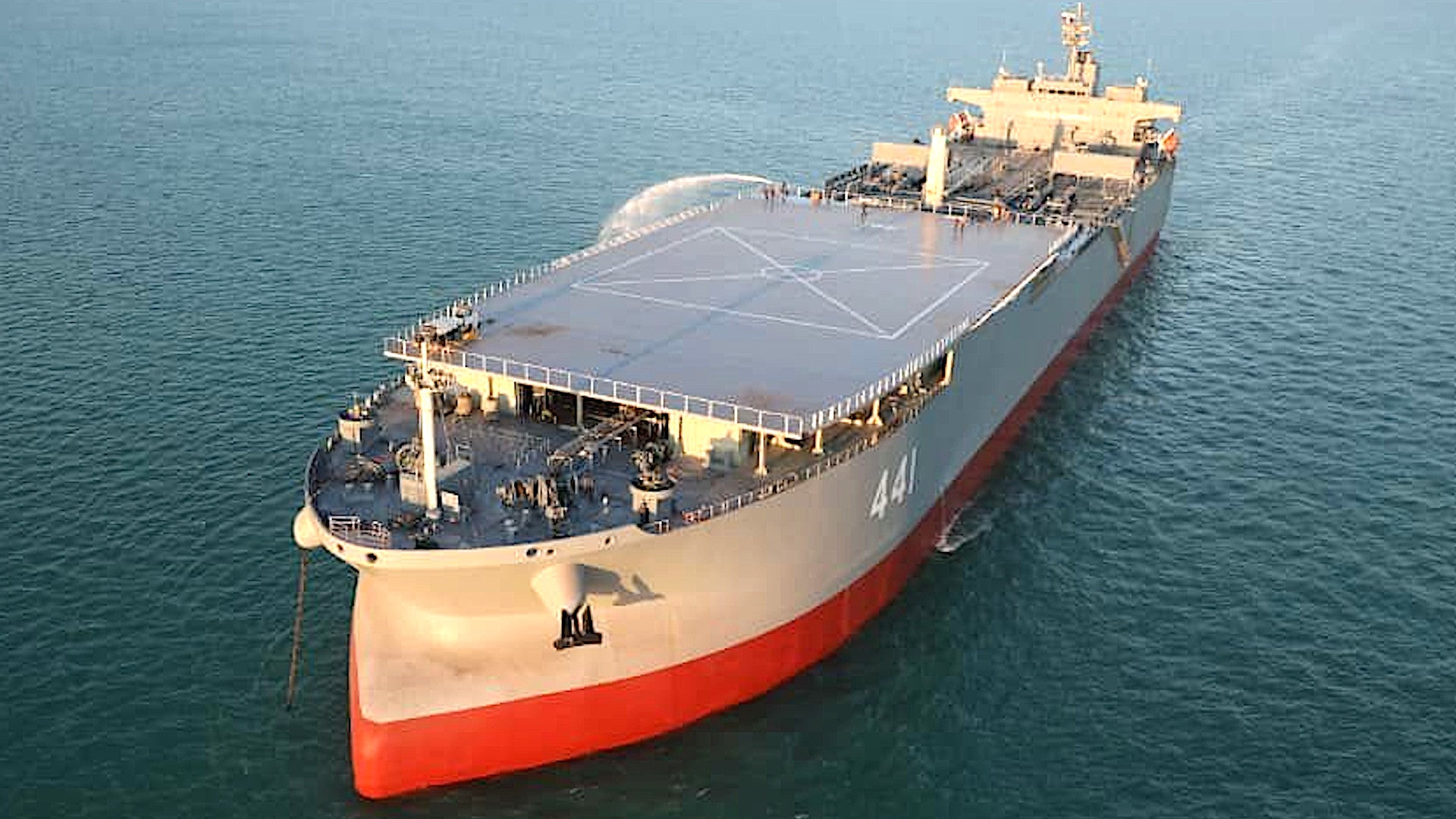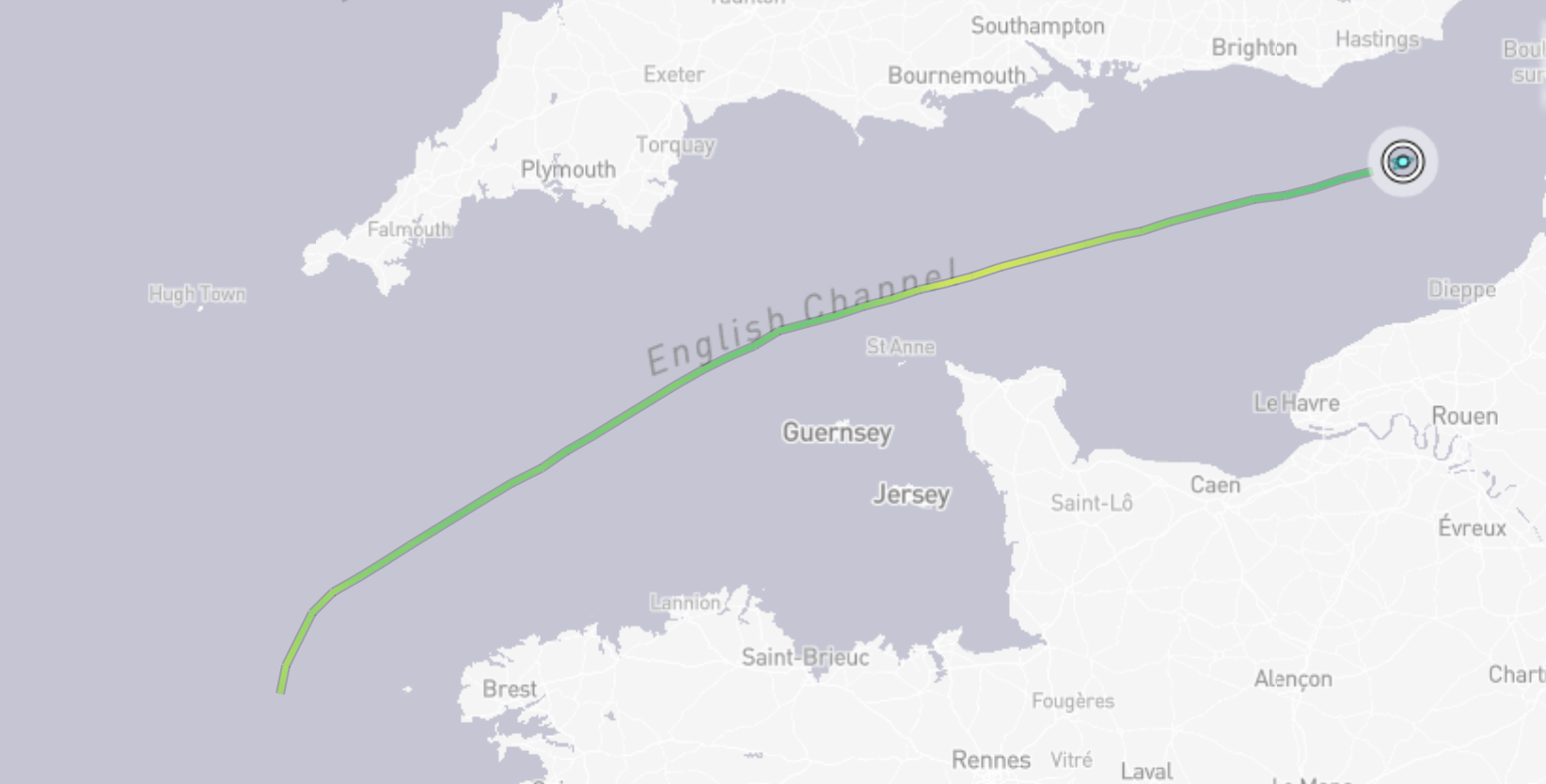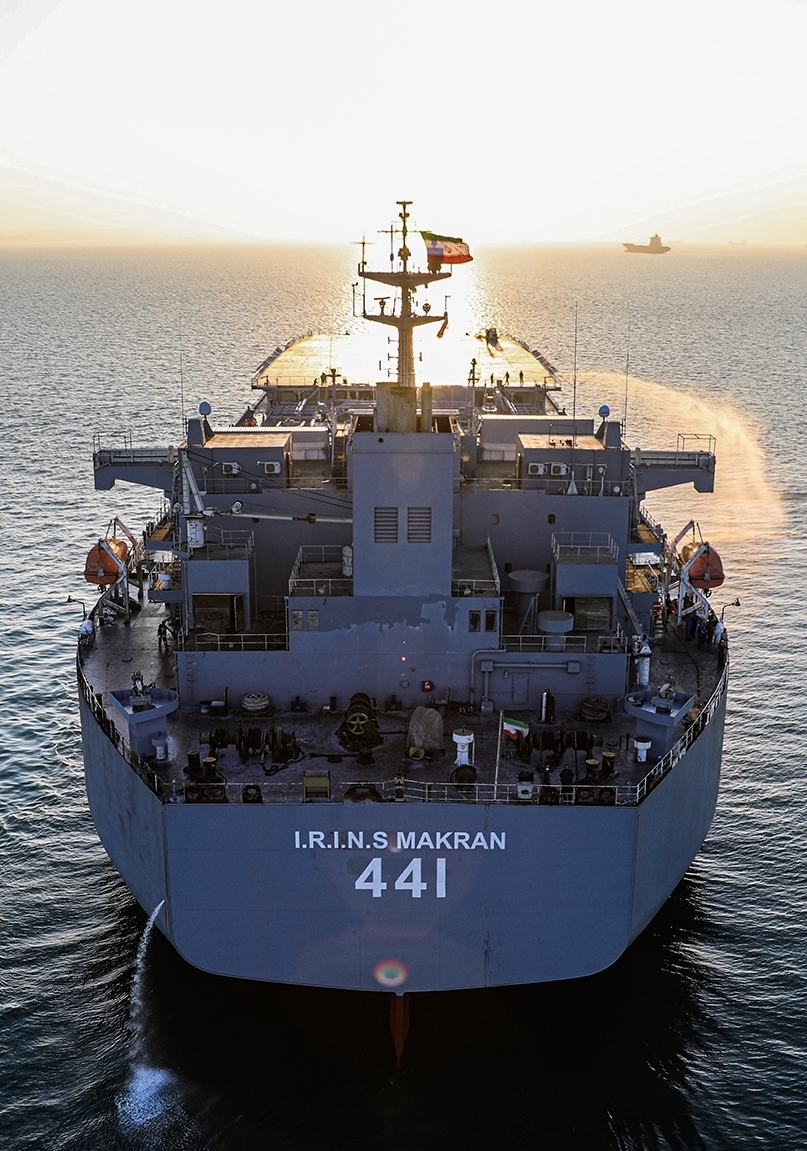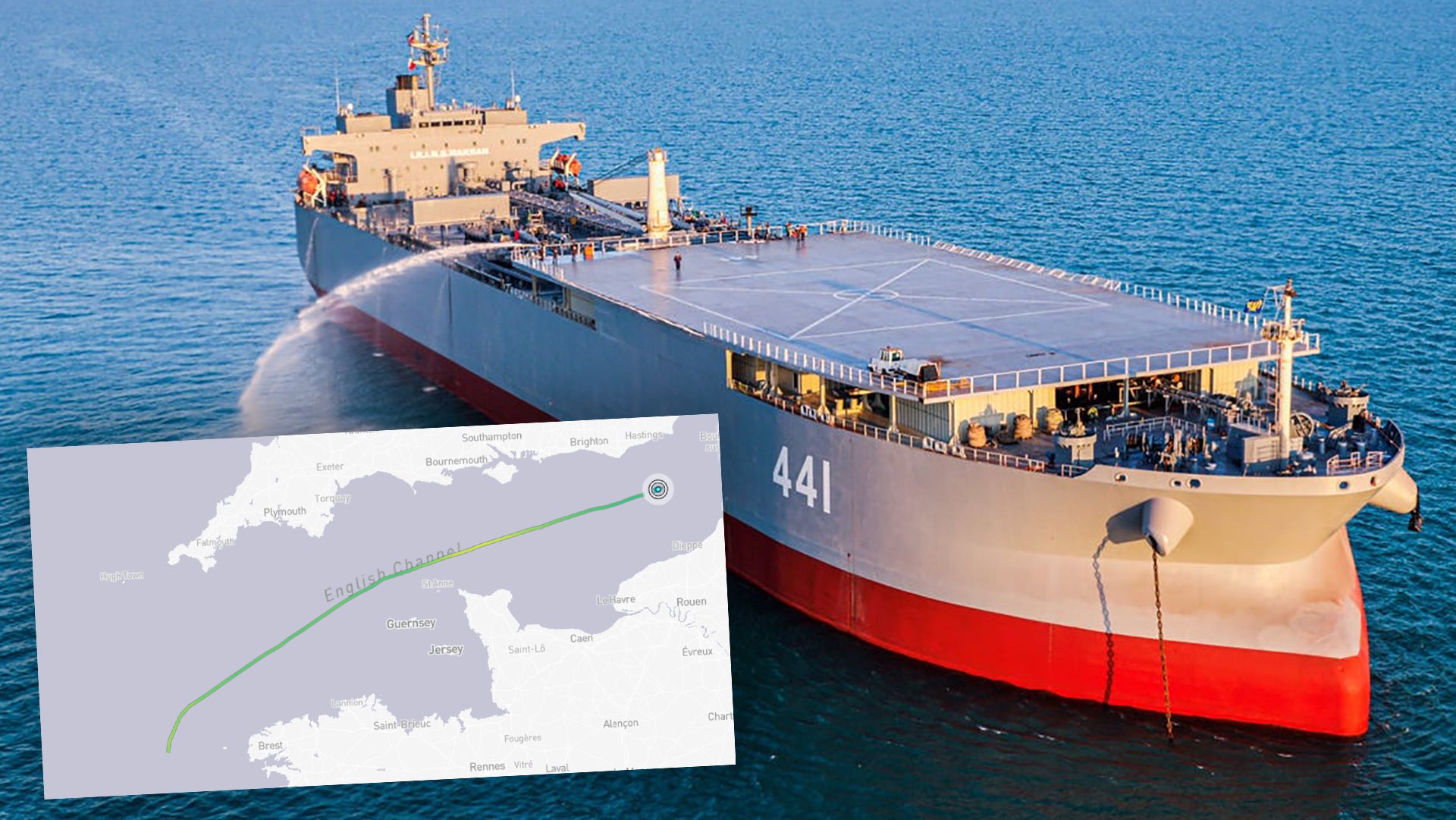In a surprising turn of events, a pair of warships from the Islamic Republic of Iran Navy, or IRIN have broken out of the Atlantic and headed into the English Channel, where they were noted today. The final destination of the two vessels, the “sea base ship” Makran and the frigate Sahand, Iran’s most modern warship, is unclear, but their passage would conform with previous reports that they are headed to the Russian port of St. Petersburg for the naval parade that takes place there later this month.
Satellite photographs first indicated that the Iranian warships were headed toward the English Channel before their presence in these waters was confirmed by data on MarineTraffic, an aggregator that provides real-time transponder information on ship movements.

While it is expected that the U.K. Royal Navy will be keeping a close eye on the Iranian vessels, earlier today they appeared to be shadowed by RRS Sir David Attenborough, a specialist research vessel owned by the U.K.’s Natural Environment Research Council and scheduled to make its first research trip to the Antarctic later this year.

After departing Iran last April, Makran and Sahand had rounded the Cape of Good Hope, in what was the first time that Iranian naval vessels had operated in the Atlantic Ocean. For a while, it was anticipated that they might cross the ocean headed for Venezuela, to deliver weapons and/or oil. In particular, the appearance of seven missile boats on the deck of the Makran, as well as what seemed to be a full load of oil or fuel, suggested it might be delivering these cargoes to its ally in South America, as part of expanding military and non-military cooperation between the two countries.
Suspicions then turned to a possible transport to Syria, where the Assad regime has been subject to long-running Iranian support, however, after spending around a week off Dakar, Senegal, the Iranian warships continued up the coast of West Africa and then rounded the Iberian peninsula and France.
Commissioned earlier this year, the Makran is a former oil tanker and, with a length of 755 feet, is the largest vessel in the IRIN fleet, drawing comparisons with the U.S. Navy’s Expeditionary Sea Bases (ESB), which are 764 feet long.

The Makran is able to accommodate helicopters, but lacks hangars, and has also been used on maneuvers with drones, fast attack craft, and mini-submarines. However, there are also concerns that Iran may exploit a legal gray area afforded by the vessel’s military status and use it to transport cargoes to countries under international sanctions, such as Syria and Venezuela. Previous Iranian efforts to deliver fuel to both Venezuela and Syria using merchant tankers have led to these vessels being impounded, while Makran is afforded additional protections under international law.
Iranian media has also claimed that the Makran will be able to undertake other missions, too, including electronic warfare and special operations. In the past, Rear Admiral Khanzadi has also talked of the vessel’s “missile and weapons capabilities,” although it is not clear what these might consist of. As a naval auxiliary, however, Makran would be prohibited from launching attacks during a conflict, at least in a legal sense, although it’s questionable whether the regime in Tehran would necessarily pay heed to that, especially in a time of heightened tensions.
If anything, the prestige and importance of the Makran have only increased in the months since it was commissioned, following the loss of the replenishment ship Kharg, which caught fire and sunk in the Gulf of Oman, last month. The Kharg had been one of Iran’s most important naval vessels and was once the biggest in its fleet. This vessel had been used to support operations further from Iran’s own shores, including a high-profile visit to China in 2013.

Accompanying the Makran, the Sahand has in the past been described by Iran as a destroyer, with a displacement of 2,000 tons, it is more accurately categorized as a frigate or even a corvette. The design is a derivative of British-made warships that were supplied to the country in the 1970s, before the Iranian Revolution.
The Sahand is fitted with launchers for Qader subsonic anti-ship cruise missiles, as well as Sayyad-2 surface-to-air missiles, an Iranian adaptation of the U.S. RIM-66 Standard Missile-1 (SM-1). The warship also features a 76mm main gun and torpedo tubes, as well as various automatic cannons and machine guns for close-in defense.

The naval parade in St. Petersburg, planned for July 25, will mark the Russian Navy’s 325th anniversary. As well as the likely appearance of the two Iranian warships, the event is also planned to feature three nuclear-powered submarines from the Russian Navy’s Northern Fleet. These are the Borei-A class ballistic missile submarine Knyaz Vladimir, the Oscar II class cruise missile submarine Orel, and the Akula II class nuclear-powered attack submarine Vepr.
Earlier this month, a writer for Iran’s Tasnim News Agency tweeted that Iranian warships were expected to join the naval parade in St. Petersburg, together with the commander of the IRIN, Hossein Khanzadi.
While the Atlantic deployment is a first for the IRIN, sending just two vessels is little more than a token force, but the importance lies not so much in the overall capabilities brought to bear, but in the demonstration of a new area of operations for the service, beyond the Persian Gulf and the Gulf of Oman.
In the past, the IRIN has operated further afield, too, but primarily in the Mediterranean Sea, the Red Sea, and the northwest portion of the Indian Ocean. The ability to conduct long-duration, long-endurance missions in the Atlantic confirms that the service is at least starting to make good on its ambitions to become a blue-water navy.

As well as a rare appearance in northern European waters for the Makran and Sahand — and for the IRIN in general — the apparent upcoming visit to the Baltic Sea is a mark of the deepening military relationship between Moscow and Tehran.
In recent months, the IRIN and Russian Navy have taken part in joint maneuvers in the Caspian Sea, while there have been repeated reports that Iran has offered Russia the use of its own naval bases on its Gulf coast, which would extend the geographical area available for combined operations beyond the landlocked Caspian and into the wider Persian Gulf, and via the Strait of Hormuz, the Gulf of Oman.
Certainly, both Iran and Russia share interests not only in supporting the Assad regime in the ongoing civil war in Syria but would also both benefit from efforts to frustrate the United States’ enduring presence in the Gulf and in the Mediterranean. At the same time, the lifting of United Nations restrictions on Iranian arms imports once again provides Russia, in particular, with a potential client for its advanced weapons systems.
With that in mind, while the imminent presence of two Iranian warships in Russian Navy celebrations in St. Petersburg is chiefly ceremonial, it could also be a portent of increasing naval cooperation between the two countries in the years to come.
Contact the author: thomas@thedrive.com
